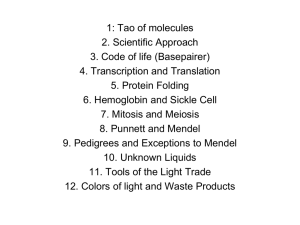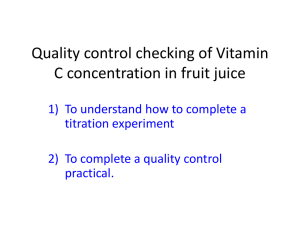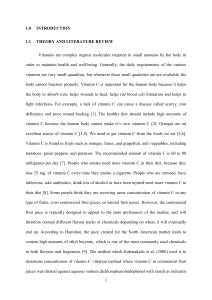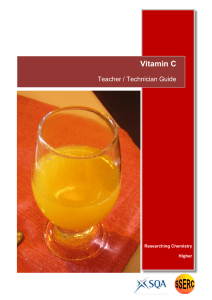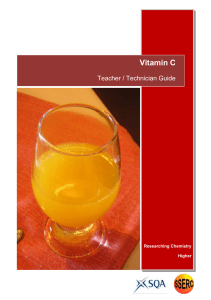Investigating Vitamin C
advertisement
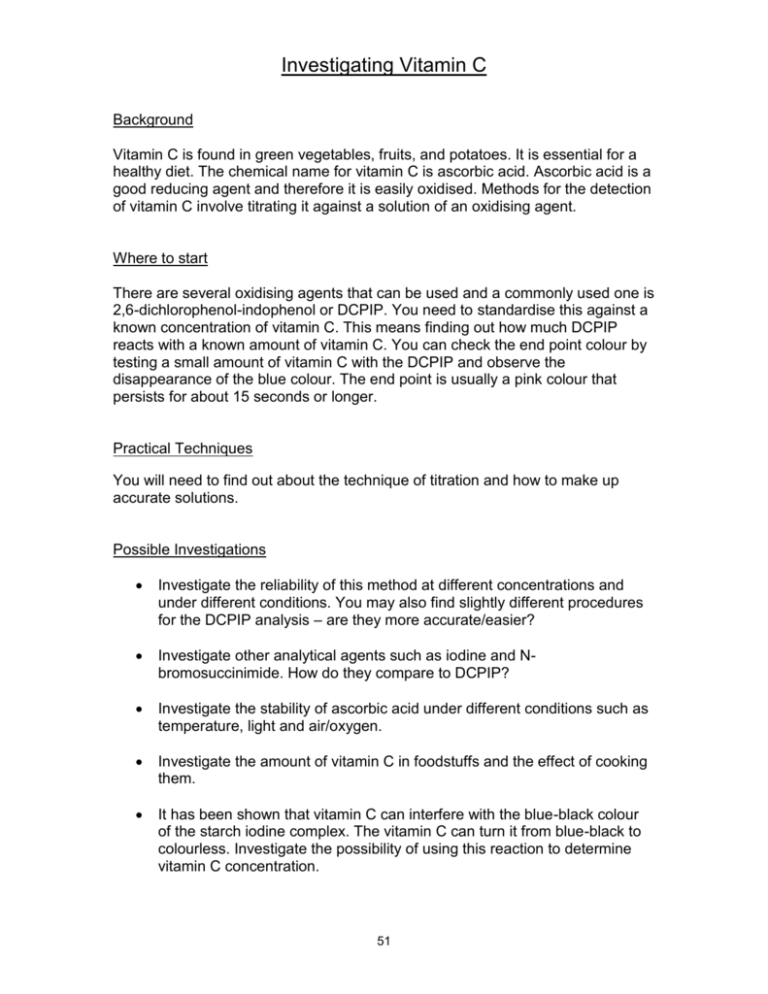
Investigating Vitamin C Background Vitamin C is found in green vegetables, fruits, and potatoes. It is essential for a healthy diet. The chemical name for vitamin C is ascorbic acid. Ascorbic acid is a good reducing agent and therefore it is easily oxidised. Methods for the detection of vitamin C involve titrating it against a solution of an oxidising agent. Where to start There are several oxidising agents that can be used and a commonly used one is 2,6-dichlorophenol-indophenol or DCPIP. You need to standardise this against a known concentration of vitamin C. This means finding out how much DCPIP reacts with a known amount of vitamin C. You can check the end point colour by testing a small amount of vitamin C with the DCPIP and observe the disappearance of the blue colour. The end point is usually a pink colour that persists for about 15 seconds or longer. Practical Techniques You will need to find out about the technique of titration and how to make up accurate solutions. Possible Investigations Investigate the reliability of this method at different concentrations and under different conditions. You may also find slightly different procedures for the DCPIP analysis – are they more accurate/easier? Investigate other analytical agents such as iodine and Nbromosuccinimide. How do they compare to DCPIP? Investigate the stability of ascorbic acid under different conditions such as temperature, light and air/oxygen. Investigate the amount of vitamin C in foodstuffs and the effect of cooking them. It has been shown that vitamin C can interfere with the blue-black colour of the starch iodine complex. The vitamin C can turn it from blue-black to colourless. Investigate the possibility of using this reaction to determine vitamin C concentration. 51 Investigate the use of sodium hydroxide as a reagent to analyse for vitamin C. It should be possible to carry out an acid /base type titration because vitamin C is an acid. Sources of Information Denby D., There’s more to Vitamin C than Brussel Sprouts Chemistry Review, May 1996 Selinger B., (1998), Chemistry in the Marketplace, Harcourt, Brace, Jovanovich, London Farley R., (2001), School Chemistry Experiments, Association for Science Education. Hill C., A simple test for Vitamin C, School Science Review, June 2002, Vol 83, No 305, p.131 Thorpe A., Assessing the risks in practical work, Chemistry Review, September 2000 Thorpe A., Experimental error and error analysis: just how good are those results, Chemistry Review, November 2001 Thorpe A., Making a standard solution, Chemistry Review, November 2002 Battye P., Titrations, Chemistry Review, February 2003 http://chem.lapeer.org/Chem1Docs/VitCAnalysis.html http://www.chem.pacificu.edu/GenChemProjects/ http://www.geocities.com/labdad.geo/lab -C-30.html http://wwwchem.csustan.edu/chem1002/vitaminc.html 52 Teachers' Notes General The article by Derek Denby in Chemistry Review is an excellent source for this investigation and students should be strongly recommended to make use of it. The end point of the DCPIP titration is often not distinct and students will probably need to familiarise themselves with the colour change. Both DCPIP and ascorbic acid deteriorate and the vitamin C should be standardised with the DCPIP frequently. Chemical Principles Redox, organic compounds, quantitative chemistry Essential Equipment Burettes, pipettes Essential Chemicals DCPIP, ascorbic acid (vitamin C), hydrochloric acid Safety No risk assessment has been given. It is essential that students prepare a detailed risk assessment before they start. Teachers must be satisfied that this is suitable for the proposed investigation. 53 Experiment Starter Sheet – Investigating Vitamin C A simple procedure to standardise the DCPIP follows. Prepare the following solutions 0.5g in 500cm3 water of DCPIP solution 0.5g in 500cm3 water of ascorbic acid solution 2 mol dm-3 hydrochloric acid solution Place the DCPIP in a burette and titrate it against 25cm3 of the ascorbic acid solution that has been acidified with 2 drops of the hydrochloric acid. You can now calculate how much DCPIP reacts with a certain amount of ascorbic acid. 54

